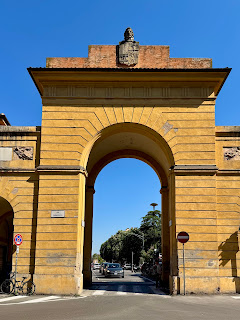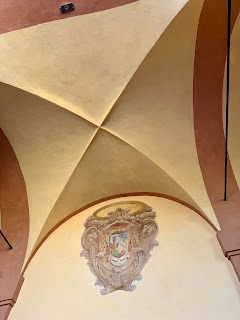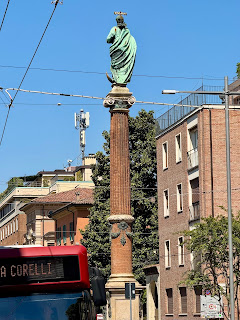Our early morning walk follows the Via Riva di Reno west, out of the historic center of Bologna (pop 390,850 in 2024). When we cross the Via Guglielmo Marconi, the main north-south arterial from Bologna Centrale, the asphalt widens, and a central parking island joins the streetscape. The parking continues all the way to the city walls and the Chiesa di Santa Maria e San Valentino della Grada (17th century). The 'della Grada' refers to the grated barricade that protects the Canale di Reno flowing beside the Chiesa and prevents the entry of floating contraband (including people).
Putting our urban planning training to work, we deduce that the parking areas cover the underground canale – free land areas taken during the 'urban renewal' of the twentieth century. And then it must pass under the Via Sabotino until it reappears beside a bike path near the Via della Certosa.
The Certosa di Bologna (Cimitero Monumentale, Carthusian monastery 'charterhouse', est 1334) is the city cemetery. Wherever we end up today, we embark from a place of memory. The dramatically stout Doric entry (20th century) is on our right, and the Ionic archway of the Portico della Certosa (19th century) is just ahead, bridging the canale.
The Portico runs south toward the Colle della Guardia (hill). Lining the western side of the porticato are shops to supply the cemetery: stone carvers, religious items, florists. But unlike the well-known Portici di Bologna, these structures are not embedded in other buildings, this Portico is its own thing, and the shops are added to it.
The mood suddenly shifts, as the shops are replaced by the Stadio Renato Dall'Ara (Stadio Littoriale, 20th century), home to the local football team, Bologna FC. The arches are marked with gate designations corresponding to sections of the Stadio. The mood then shifts back at the Torre di Maratona al Littoriale (20th century); integrated into the Portico, the Torre marks the site of Ugo Bassi's execution, across from the Piazza della Pace.
The Portico della Certosa joins the Portico di San Luca (17th-18th centuries) at the Via Saragozza. Another porticato comes from the east along that same street. The two paths converge at a rusticated Doric archway with triglyphs then ascend to the Arco del Meloncello (Carlo Francesco Dotti, 18th century) and cross the Via Porrettana.
The design of the Arco del Meloncello is an exuberant Ionic triumphal arch, with a raised percorso; the lower Doric order meets an Ionic giant order. The result of the collision of the portici is a squiggly, serpentine start to the Portico di San Luca. Just above the start point is a sign that reads:
DIVÆ ANGELORUM REGINAIN MONTANA ABEUNTI AD CUSTODIAM PATRIÆ VIAMPORTICIBUS AUGUSTAM MISTERIS SACRAMPRIMUS APERUIT CAROLUS MORETTUS[Divine Queen of Angelswent to the mountains to guard the path of the countrythrough the august portici of the sacred mysterieswhich was first opened by Charles Morettus]
Another sign, in Italian rather than Latin, carries this instruction:
LASCIA O PASSEGGIERE DI SCRIVERE OIN ALTRO MODO IMBRUTTARE QUESTECOLONNE E QUESTE MURASE SPREZZI LI BANDI SE NON TEMI LE PENEIN ESSI MINACCIATE,PAUENTA ALMENO PER IL DISPIACERECHE PORTI A MARIA SSMA DI CUI SONOQUESTI ARCHI, E QUESTE MURA[Let the passerby write orin other way deface thesecolumns and these wallsif you despise them or the banners if you do not fear the punishmentsthreatened therein,at least fear the displacementthat you may bring to Mary Most Holy whosearches and these walls are]
The percorso does appear remarkably clean and in good shape. But today is Calendimaggio (May Day), a national holiday. All around and beyond the Arco, the crowd squeezes into the passage. Some try to run by in their jogging gear, others stop to reply to texts messages or pose for selfies, still others strut past with hiking boots and walking sticks. Like a cammino, much of the 'mistero' is removed from the experience if one rushes or ignores the intention.
The final two-kilometer length of the Portico, from the Arco to the Santuario, is segmented by fifteen chapels of I Misteri del Rosario. Each contains a fresco image of an episode of the 'I Misteri', and thus the cappelle act like prayer beads.
At the end of the 'squiggly' part of the walkway is the Chiesa di Santa Sofia All'Arco del Meloncello (18th century) and a tall doorway leading to the first station, which reads: 'I. Mistero: Annunziazione di Maria Santissima' (Annunciation). Unfortunately, the doors are shut, so we cannot experience the first cappella (visible in this video).
Additional frescos include the colorful and evocative testimonials and heraldry for the benefactors of the Portico.
Mistero II: La Visita di Maria Santissima a Santa Elisabetta (Visitation) is not a painted fresco but a bas-relief. Exposed to the elements, pilgrims, and tourists, and despite the protection of its domed enclosure between Archi 342-343 (Catalogo degli Archi), this sculpted panel (Giuseppi Romagnoli, 1902) replaces an original seventeenth century fresco. In addition to Mary and Elisabetta, the composition includes Joseph and Zacharias, their husbands, and the tree of life.
Mistero III: La Nascita di Gesù (Nativity; Giacomo Pavia, 1725 original; Renato Pasqui, 1955 restoration) survives from an attack with pink paint in 1979 (Misteri III-VII). The familiar birth scene is joined by Adam in the left panel, David with his harp on the right, and angels with a banner above: Gloria in Excelsis Deo.
Here, at Archi 367-368, the road curves to the right and gives views of the exterior down and up along the Via di San Luca.
Mistero IV: Gesù Viene Presentato al Tempio da Maria e Giuseppi (Presentation of Jesus, Giuseppe Mazzoni, early 18th century) is in rougher shape. Though the columns and stairs of the temple are intact, the faces and figures are difficult to read. The central figure appears to be Joseph holding Jesus. Just past Archi 388-389, another more recent fresco is a beautifully intact memorial (Arco 403, 'Ridolfi', 1973).
Mistero V: Gesù al Tempio (Finding in the Temple, unknown artist, 18th century) looks much better, and is the last of the Misteri Gaudiosi (Joyful). In this scene, on the left, Mary and Joseph discover the Child Jesus speaking to the doctors of the Church. Above, in an octagonal 'opening', a cherub carries a banner, perhaps still vibrant from a recent touch-up:
INVENERUNT ILLUM IN TEMPLO SEDENTEM IN MEDIO DOCTORUM[they found him in the temple sitting in the midst of the teachers]
From Arco 410, as the 'Joyful' mysteries end, the city gives way to the countryside. Mistero VI is behind netting and not visible; it should be the first of the Misteri Dolorosi (Sorrowful), L'Agonia di Gesù nell'Orto degli Ulivi (Agony in the Garden, link to image). Here, the road bends back to the left.
Mistero VII: La Flagellazione di Gesù (Flagellation of Christ, 18th century) is in dire need of attention, the lower quarter is gone, and the rest of the image is faded and colorless. It's a shame that an image by a known master, Aureliano Milani, is in such a state, but we hope the conservation team working on VI is preparing for VII.
Mistero VIII: La Coronazione di Spine (Crown of Thorns, Nicola Bertuzzi, 18th century, 1907 restoration) is a much better example of the Misteri Dolorosi; perhaps this series is painted in grey tones to evoke the sorrows: "IN ÆRUMNA CONFIGITUR SPINA, Ps. 31." At this point, the percorso is elevated above the roadway, and we cannot step through the columns for street views.
Soon after VIII, the roadway crosses under the vialetto, and the arcade opens on both sides. Then, it breaks from west to south, with the next cappella set at the knuckle. Mistero IX: Gesù che Porta la Croce al Monte Calvario (Christ Carrying the Cross; Giuseppe Pedretti, 18th century; Luigi Simoncini, 1906 restoration) supplies the missing color: a swirl of flaming reds and smokey whites and the tough figure of Christ under the Cross.
Mistero X: Crocifissione di Cristo (Crucifixion, 1993) is a terracotta relief by Camilo Bersani. On the left, Christ is on the Cross in marvelous perspective, with Mary and John the Evangelist at His feet. A portrait of San Pio V looks down from the roundel. Past Arco 512, the percorso carves into the hillside and grows steeper, requiring steps to make the elevation change.
The arcade is now closed on the east but open to the west, with stunning panoramas of the green hills and the city's towers. Another fresco added by the children of Bologna (Arco 515), with shockingly well-constructed perspective, declares:
CIVITAS DEI ADOLECENTIUM CIVITAS[city of God city of youth]
Mistero XI: Risurrezione di Gesù (Resurrection, Giacomo Boni e Luca Bistega, 18th century) begins the Misteri Gloriosi (Glorious). The image depicts Christ rising from his tomb through a flash of divine light toward an opening in the sky, above a tumble of angels and blinded bystanders. In the side arch, San Luca paints the L'Icona della Madonna (hard to see or photograph past the chain link); and at the top, a delightful multi-lobed dome in trompe-l'œil.
After another set of stairs in Arco 532, the path levels out but continues to climb. Interesting that as we leave the 'Sorrowful' behind for the 'Glorious', the open view switches sides. But frustratingly, many visitors are standing with their backs to the chapel looking out at the scenery, not moving.
Mistero XII: Ascensione di Gesù al Cielo (Ascension, Angelo Dalla Volpe e Tertulliano Tarroni, 18th century) is less clear than the previous fresco, but shows the next logical image, Christ in Heaven and the awestruck bystanders now looking up towards Him. This is between Arci 552-553, a slight turn to the right with stairs on either side
Mistero XIII: La Discesa dello Spirito Santo nel Cenacolo (Pentecost) is now under restoration and is difficult to view behind the scaffolding. If this is an example of future outcomes, the drama of the Portico is 'going up to eleven': rich reds and deep blues, a spark of light from the Holy Spirit above the Apostles, shadows and contrasts that make the faces and figures really pop. Just after XIII, the Via di San Luca crosses the Portico, and the view flips back to the northwest, as we make our final ascent.
Mistero XIV: La Assunzione di Maria al Cielo (Assumption of Mary, Jacopo Alessandro Calvi e Gaetano Alemanni, 18th century) is another misty image, though the portrayal of the Virgin is quite clear. The lower half is filled with a smear of small 'earthly' figures, seemingly out of scale, while the middle is a group of 'helper' angles.
The dome and adjoining arches (Archi 598-599) above the cappella are fully and fantastically rendered with trompe-l'œil detailing. We imagine this standard of polychrome and texture throughout the corridor. This cappella is open to the street, and stepping out, we get our first good look at the Santuario at the top of the hill (top image).
Mistero XV: L'Incoronazione di Maria Vergine (Coronation of the Virgin, Dalla Volpe e Tarroni, 18th century) shows the Father, Son, and Holy Spirit placing a crown on Mary, with many more cherubs and angels. From this location, Archi 634-635, the passage becomes extremely crowded as the exhausted walkers gather along the many staircases that make up the final stage.
The long journey ends with a simple Cross after Arco 658 within a five-sided, domed dovecote. We give our sincere thanks. The dovecote is a switchback; the stairs wheel and become the swooping north wing of the Santuario della Madonna di San Luca (12th century, original; Dotti, 18th century). The Doric columns reappear. And now we get an extra reason for the backup: people frozen at the parapet from the sight of the Santuario from the arcade as well as the Portico as it snakes up the rise.
By the entrance, San Luca (ox) and San Marco (lion, Bernardino Cametti, 1716) greet us. We buy timed tickets for the 'San Luca Sky Experience', but the church is amid service, and the ticket agent asks us to wait. But the guard considers us and motions for us to slide in sideways; the stairs to the cupola are just inside.
We quickly look into the nave before we climb. We've been studying the satellite map during our walk, and cannot reconcile the traditional Latin cross interior with the centralized oval of the exterior – a bit of architectural alchemy.
We make our way up; the attic is not far. Then, we need to cross the structure above the ceiling vaults. We exit onto the lower balcony of the exterior platform, attain the full height of both the Colle and Santuario, and are amazed by the prospect. The hills are a patchwork of fields, groves, and little forests stretching to the hazy silhouettes of the mountains. The platform is an appendage on the south side and at the base of the circular upper dome, which sits in the center of the raised, oval roof; Bologna is to the east.
When we reach the upper platform, a small tour group departs, and we are alone with just the docent. We pause and absorb the silence and sunlight. Seeking something divine, we find it here.
DELLA SCAlA ESTERNA A QUESIA CUPOLA
DELIBERATA DAI FABBRICIERI DEL SANTUARIO
E DAL LORO COLLEGA ED INGEGNERE
ALESSANDRO ROFFENI TIRAFERRI
MAESTRE VOLMENTE IDEATA E DIRETTA
L'ANNO 1883
IL CANº CATUREGLI
PEL VANTAGGIO VENUTONE ALL'OSSERVATORIO
A PERENNE MEMORIA
POSE
[Of the external staircase to this dome
determined by the builders of the Sanctuary
and by their colleague and engineer
Alessandro Roffeni Tiraferri
maestre voluntarily conceived and directed
in the year 1883
the Canon Caturegli
for the advantage that has come to the observatory
in perennial memory
placed]
Returning into the Santuario, the service is completed, but the space is still full. In the altar is L'Icona della Madonna di San Luca (full image here). A jeweled glass sheet masks the ancient painting and frames the faces of the Madonna and Child. Local legends tell the unlikely story that L'Icona is the actual handiwork of San Luca Evangelista, brought to Bologna by a Byzantine monk. Casework protects the painting when it is the centerpiece during the festival (from the Santuario to the Cattedrale).
L'Icona sits in a shallow aedicule, decorated with gilt cherubs and tracery. Above this, a pair of larger angles sit on either side of the Holy Spirit. The fresco in the half dome shows the Madonna e Bambino with the Santissima Trinità, and San Luca on the right with his paint brush. The cartouche requests the Madonna:
SUPER OMNEM GLORIAMO, PROTECTIO[I glorify above all, protection].
The dome over the chancel includes portraits of priests and nuns as well as a fantastic rendering of the city's skyline, with its crooked towers. The classical orders shift from Ionic, to Corinthian, to Composite, becoming more exuberant as the architecture moves to meet the worshippers. The main dome is a cyclone of glowing clouds, angels, and figures all drawn to the Holy Spirit at the top of the lantern.
The tall paintings in each transept add to the Marian themes: I Protettori di Bologna (with San Petronio and Bologna) in the Evangelist side (north), and L'Incoronazione di Maria at the Epistle side (south, Donato Creti, 1730).
We leave the Santuario from the south dovecote and arrive on a formal lawn between the wings of the curvy M-shaped gallery. We back ourselves to the west trying to get the best full image of the extraordinary church and its grounds. We can only twist the camera this way and that, trying to compose the entire tangled facade – attempting to capture in two dimensions something that requires three.
Perhaps we are here on the wrong day, but the experience is a memorable one. We process our thoughts during the calm and pleasurable descent. At the Arco del Meloncello, we keep right on the Via Saragozza rather than follow the Via della Certosa. This is the more 'official' Portico, and the walkway along Saragozza is lined with cafes, shops, and restaurants (many closed today). We find lunch at a terrific tigelleria and enjoy our meal within the arcade.
The arcade ends at L'Arco Bonaccorsi (17th century), considered 'Arco 1'. We cross the street and re-enter the old city at the romantic Porta Saragozza (13th-14th centuries).
Walking to dinner along the Via Riva di Reno, we remember what Riva di Reno means – we're above water. Checking our maps, we track down the Canale di Reno, which is open and visible from a street crossing near the popular Ristorante Donatello.
We find the Finestrella di Via Piella. The tenants of the buildings have added theatrical lighting and created a joyful, hidden space. We finish at the opposite end of the same canal from our start this morning. As with any worthwhile journey, we seek connections that make it meaningful and surprises that make it wonderful.































































































No comments:
Post a Comment